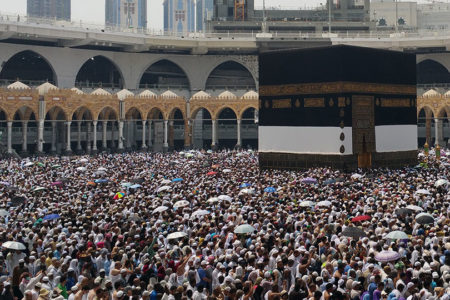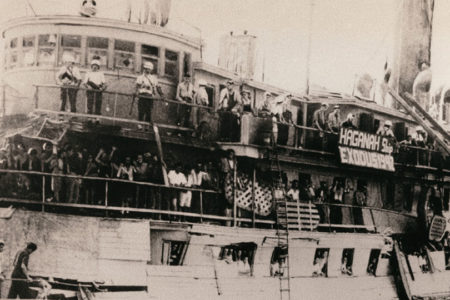Jerusalem and the Muslims
Most people know Jerusalem is important to three major religions: Judaism, Christianity, and Islam. What many may not know is that the city is referenced in the holy writings of Christians and Jews only and has only been the capital of the Jewish people.
Yet Islam considers Jerusalem its third holiest place. On any given day you can watch news from the Middle East and see Islamic crowds vowing to spill their blood for the sake of Jerusalem.
At the funeral in 2014 of a terrorist named Sarhan, the crowd shouted, “Sarhan, rest in peace, we will continue the struggle! With soul and with blood we will redeem you, Sarhan! Oh prisoners, we are united, and we have defeated the enemy! Millions of Martyrs (Shahids) are marching to Jerusalem.”1
Why such fervor when the Qur’an, Islam’s holiest book, doesn’t even mention Jerusalem? And Islam’s holiest site is Mecca. After Mecca comes Medina. Both are in Saudi Arabia. Muslims pray toward Mecca, with their backs toward Jerusalem. It is the Jewish people who pray facing Jerusalem.
So why do Arabs shout in the streets, “We will sacrifice our blood and souls for you, Jerusalem”? What is it about Jerusalem that makes the Muslims want it? The answer lies in the nature of Islam.
In Islamic theology, once Muslims capture something, it is a disgrace to lose it. The Jewish presence in Jerusalem and, in fact, all of Israel, disgraces them. So they will do whatever it takes to eradicate the Jewish presence and recapture what they lost.
Today Arabs speak of Jerusalem as though it were their holiest city. But when the Muslims ruled the area, Jerusalem was never their capital. And it was never the heartbeat of Islam.
For almost 1,100 years, Jerusalem was the focal point of Jewish life. It was the capital of the Davidic dynasty for more than 400 years and the capital of the Jewish people in their land for five and a half centuries, following their return from the Babylonian Captivity—even though they were no longer sovereign.
But in AD 70, when Rome crushed a Jewish rebellion that had been brewing for years, it destroyed the city and the Jewish Temple.
In AD 135, Roman Emperor Hadrian crushed another Jewish rebellion. To ensure the Jewish people would not attempt to retake the city, Hadrian paganized it, changing the district name from Judea to Palestina (hence, the name Palestine) and renaming Jerusalem Aelia Capitolina.
He also outlawed all Jewish residency and practices. The city remained pagan until AD 335 when Roman Emperor Constantine converted to Christianity. With the help of his mother, Helena, who oversaw the building of many churches, including the Church of the Holy Sepulchre, he made Jerusalem a Christian center.
Enter Islam
In the seventh century, a new religion arose in the world—Islam. For years, the Kaaba (a mosque built around a black stone) in Mecca was a place of worship for Arabs, who had more than 300 gods.
Muhammad (AD 570–632), believing himself to be a prophet, claimed to receive new revelation from an angel and began to teach against polytheism, advocating belief in one God whom he called Allah. His fellow Meccans rejected his teaching; and in 622 he was forced to flee to Medina, a city with many Jewish residents. He presented himself to the Jews as a prophet and tried to attract them with Jewish-like practices.
According to Islam expert Daniel Pipes, Muhammad provided “a Yom Kippur-like fast, synagogue-like place of prayer, permission to eat kosher food and approval to marry Jewish women. Most important,…[he] repudiated the pre-Islamic practice of the Meccans to pray toward the Ka’ba,”2 teaching them to pray toward Jerusalem. He believed Jewish people would embrace his teaching because it was so much like theirs.
But Muhammad was wrong. The Jews of Medina embraced neither him nor his teaching. Wrote historian Paul Johnson, “Mohammed’s development of a separate religion began when he realized that the Jews of Medina were not prepared to accept his arbitrarily contrived Arab version of Judaism.”3
Mohammed… gave a deliberate new thrust to Islamic monotheism. He altered the nature of the Sabbath and changed it to Friday. He changed the orientation of prayers from Jerusalem to Mecca. He redated the principal feast. Most important of all, he declared that most of the Jewish dietary laws were simply a punishment for their [Jewish people’s] past misdeeds, and so abolished them, though he retained the prohibitions on pork, blood and carcasses, and some of the slaughtering rules.4
To this day, Islam is a revisionist religion that changes repeatedly based on expediency. Muhammad died in 632, leaving no male heir. Abu Bakr took the title of caliph (leader or deputy of Muhammad). Succeeding him was Caliph Omar, who led the Arabs to conquer Syria; Iraq; and in 638, the center of Christianity, Jerusalem.
Islam Gains Control
Omar is said to have been shocked at the filth and rubble that lay strewn about the Temple Mount. Because the holy site had been neglected, he made the Christian Patriarch Sophronius grovel in the muck. Afterward Omar set about clearing the site. He built a wooden mosque on the compound. Most scholars believe the mosque was built on the foundations of an early Christian Church.5
In 661, the Umayyad dynasty began ruling and established the capital of the Muslim empire in the Syrian city of Damascus. The ruling caliph instituted many reforms in the mostly Christian city of Jerusalem. The Jews, considered “people of the book,” were now permitted to return and resettle the city.
Desiring to build a symbol of Islamic victory over Judaism and Christianity, Arab Caliph Abd al-Malik built the Dome of the Rock in 688 on the site that had housed the two Jewish Temples. It was designed and crafted by Byzantine architects who made sure it was much larger than the Church of the Holy Sepulchre, built 300 years earlier. Inside the Dome is an outcropping of the bedrock of Mount Moriah. The Dome is considered the oldest Islamic monument in the world.
Jerusalem’s importance to Islam derives primarily from the traditional story attached to Muhammad, called the Night Journey. According to the Qur’an, Allah took Muhammad by night “from the most sacred mosque to the furthest mosque, whose precincts We blessed, in order that We might show Him some of Our signs; for He is the One Who hears and sees [all things].”6
Muhammad is said to have mounted a winged steed named al-Buraq (“lightning”) and been guided by the angel Gabriel from the Kaaba in Mecca to the furthest mosque. There he supposedly prayed with Adam, Abraham, Joseph, Jacob, Moses, and Jesus. From that rock Gabriel is said to have guided him by a ladder of light into heaven where he saw Paradise and spoke with Allah.
The is vision is extremely important to Islam today. However, at the time of the vision, there was not a single mosque in what had been the Jewish capital.
“Then, in 715, to build up the prestige of their dominions, the Umayyads did a most clever thing,” wrote Daniel Pipes. “They built a second mosque in Jerusalem, again on the Temple Mount, and called this one the Furthest Mosque (al-masjid al-aqsa, Al-Aqsa Mosque). With this, the Umayyads retroactively gave the city a role in Muhammad’s life.”7
It was a master stroke of Islamic revisionism.
According to Muhammad ibn al-Hanafiya (638-700), a close relative of the prophet Muhammad, “These [Umayyads] pretend that God put His foot on the Rock in Jerusalem, though [only] one person ever put his foot on the rock, namely Abraham.”8
The Umayyad rule came to an end in 750 when other Arab tribes became agitated and replaced the dynasty with a new Arab group called the Abbasids. Their caliph’s capital was Baghdad in what is today Iraq. The Abbasids had little regard for Jerusalem other than to tax it heavily.
Jerusalem became a neglected city and fell into obscurity. By 1016 the Dome of the Rock collapsed. Its gold was stripped to pay for repairs to the al-Aqsa Mosque. This period was marked by numerous uprisings and wars triggered by the burden of heavy taxation.
Under the Muslims, Jerusalem would remain an obscure city until the Crusaders captured it in 1099.
ENDNOTES
- Itamar Marcus and Nan Jacques Zilberdik, “Abbas representative calls murderer of mother and children ‘a brave, heroic fighter,’” March 4, 2014 <palwatch.org/main.aspx?fi=157&doc_id=10832>.
- Daniel Pipes, “The Muslim Claim to Jerusalem,” Middle East Quarterly, September 2001 <danielpipes.org/84/the-muslim-claim-to-jerusalem>.
- Paul Johnson, A History of the Jews (New York, NY: Harper & Row, 1987), 167.
- Ibid.
- Lambert Dolphin, “Allah and the Temple Mount” <templemount.org/allah.html>.
- Tariq Ramadan,“The Night Journey,” IslamiCity.com, May 26, 2014 <tinyurl.com/MNiteRd>.
- Pipes.
- Ibid.







